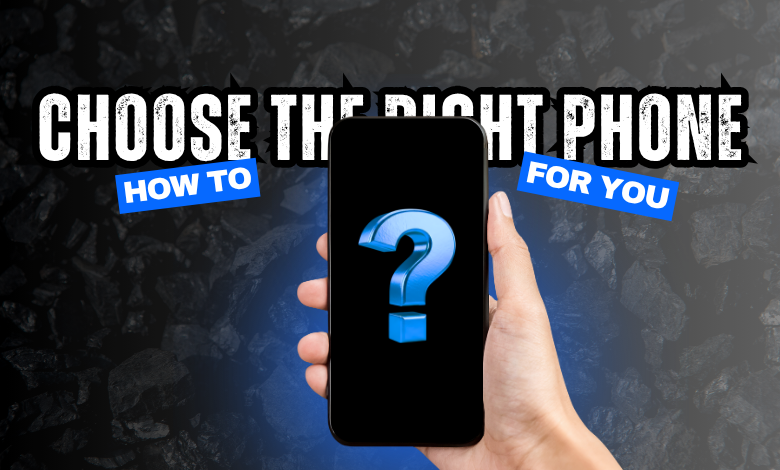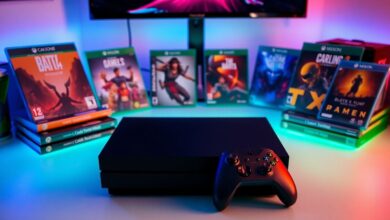How to Choose the Right Smartphone in 2025

Picking out a new smartphone can feel overwhelming with so many choices out there. You want something that fits your life, works well, and doesn’t blow your budget. Whether you’re glued to your phone all day or just need it for the basics, it’s smart to take a step back and figure out what actually matters to you. In this guide, I’ll walk you through how to choose the right smartphone without getting lost in the details or spending more than you need to.
Key Takeaways:
- Think about how you use your phone every day before shopping for a new one.
- Set a clear budget for both the phone and your monthly plan to avoid surprises.
- Pick an operating system (like iOS or Android) that matches your habits and comfort level.
- Check which carriers have strong coverage and good plans in your area.
- Test phones in person and read real user reviews before you make a final decision.
Assessing Your Need for a Smartphone
Thinking about getting a new smartphone sounds easy at first. You just want something that works, does what you need, and maybe is a little fun. But before you push that ‘buy’ button, it’s worth sitting down and actually asking yourself how much you really use your phone—there’s no point in spending a ton if you barely touch it except for calls.
Evaluating Daily Usage Habits
Start by tracking how you use your current phone each day. Ask yourself:
- Do you keep your phone close by at all times, or do you sometimes forget about it for hours?
- Are most of your conversations through calls, texts, or messaging apps?
- How often do you browse the web or check your social media?
- Do you use your phone for GPS, music, or reading?
If you mostly use your phone for short calls and the occasional text, you might not need the newest, fastest smartphone. But if you’re always online, constantly checking emails, or like sharing photos and videos, then a smartphone makes a lot more sense.
Weighing Essential Versus Optional Features
It’s tempting to go for a phone loaded with features—after all, more is better, right? But not every bell and whistle will matter to you. Here’s a table to help split the features:
| Purpose | Essential Features | Optional Features |
|---|---|---|
| Communication | Calls, Texting, Email | Video calling |
| Entertainment | Music, Video Streaming | High-end gaming |
| Everyday Convenience | Navigation (GPS), Alarm | Health sensors, NFC Pay |
Ask yourself what you would really miss if it was gone. You might realize that some features sound cool but wouldn’t actually get much use in your daily routine.
Considering the Impact on Your Lifestyle
A new phone isn’t just a purchase—it’s a shift in how connected you are. Having a smartphone can:
- Keep you plugged into work and social media all day (useful, or distracting).
- Combine lots of gadgets into one (music player, camera, GPS, etc.).
- Let you keep in touch with family, share photos, and get news instantly.
But also:
- It’s easy to get distracted and lose time scrolling.
- The cost can sneak up on you, with both upfront and ongoing monthly expenses.
- You might feel pressure to always be available, especially for work.
Before you commit, picture your day-to-day life with and without an always-connected device—sometimes, unplugging works better for your mental space than you’d expect.
The bottom line: matching your phone to your needs helps you spend less, stress less, and actually enjoy your device more.
Setting Your Budget for Purchase and Plans

Working out how much you can spend on a smartphone should come before you even glance at any adverts or walk into a store. The right budget will help you avoid overspending and land a device that won’t wipe out your bank account. The cost isn’t just about the phone itself, but also about ongoing plan expenses that can sneak up on you if you’re not careful.
Comparing Device Costs and Promotions
Device prices range from a couple hundred bucks to more than a thousand, but don’t let the shiny models fool you. These quick points can help you compare smartly:
- Check for special offers, trade-ins, or student discounts—they can make a pricey phone much more affordable.
- Decide if you’re okay with an older model or refurbished phone. Sometimes, last year’s phone does everything you need for a lot less cash.
- Watch out for bundles. Some retailers toss in headphones or cases, but ignore extras you won’t use.
| Model Type | Typical Price Range ($) |
|---|---|
| Entry-level | 200 – 400 |
| Mid-range | 400 – 700 |
| Premium / Flagship | 800 – 1200+ |
Many times, the device you want goes on sale right after you buy it. If you’re not in a rush, waiting a few weeks can save you money or score better deals.
Analyzing Monthly Plan Expenses
Your plan choices are what add up over the long run. Don’t just grab whatever your friend has or pick the first thing you see. Instead:
- Figure out exactly how much data, minutes, and texts you really use every month. Paying for unlimited everything isn’t needed by most folks.
- Look at contract length. A shorter contract might cost more up front, but offers more freedom.
- Check for hidden fees—activation, cancelation, and extra data charges stack up fast.
- For budget plans with reliable coverage, something like Fizz’s 3GB plan could be just what you need if you’re in Quebec, Ontario, Alberta, BC, or Manitoba.
| Plan Choice | Monthly Cost ($) | Data Included | Notable Terms |
|---|---|---|---|
| Low-Tier | 25 – 40 | 1 – 3 GB | Pay-as-you-go/No contract |
| Mid-Tier | 40 – 70 | 4 – 10 GB | Sometimes contract-free |
| Unlimited/Data | 75 – 120 | Unlimited | Often contracts/bonuses |
Factoring in Long-Term Value
That first payment is just the start. Think about how much the whole package will cost over the life of your phone:
- Tally up the total cost for 1-2 years: combine phone price plus 24 months of plan fees.
- Consider phone resale value—some brands keep their worth longer, so you can resell and fund your next upgrade.
- Check what support or OS updates are like for your chosen model. If the phone won’t be updated, it’ll be outdated faster.
The cheapest phone or plan up front isn’t always best. Sometimes, spending a bit more leads to lower stress or bigger savings over time.
Choosing the Best Operating System for You
Selecting a smartphone operating system isn’t just about what’s popular—it’s about what really fits your habits and expectations.
Comparing iOS, Android, and Others
Let’s be honest: the operating system determines how much you’ll enjoy your phone day to day. iOS (for iPhones) and Android lead the market, but you’ll spot some folks who still hang on to Windows or Blackberry. Here’s a quick rundown to show how they measure up:
| System | Customization | Device Choices | Price Range | Updates |
|---|---|---|---|---|
| iOS | Low | Few (iPhone) | High-Mid | Regular |
| Android | High | Many brands | Any | Varies |
| Others | Limited | Limited | Low-Mid | Sporadic |
Android lets you tweak nearly everything—home screens, widgets, notification setups—while iOS keeps things cleaner and simpler. Updates are more frequent and predictable on iOS devices, too. To see a side-by-side breakdown of both, try reviewing comparison specifics between Android and iOS.
App Availability and Compatibility
Not every app works everywhere. iOS users get a wider selection for games and creative tools, but Android keeps closing the gap. Think about this:
- iOS App Store tends to get new, popular apps first.
- Android’s Play Store still has just about everything mainstream, often with more free options.
- Windows and Blackberry are fading, so newer apps may never arrive there.
If you rely on a few apps for work or hobbies, it’s smart to search for them before you lock yourself into a system.
User Interface and Ease of Use
The way your phone feels under your fingertips is crucial (sorry—couldn’t help myself). Some folks want a system that just works, while others love options and flexibility. Look at these quick points:
- iOS: Always consistent, updates don’t change the core experience much, easy to learn
- Android: Customizable, but can feel cluttered or confusing depending on brand
- Others: Vary a lot, sometimes not as smooth or modern
When you’re standing in line, fiddling with your phone, the last thing you need is an awkward interface making everything harder.
Take your time, read up, and try a few phones in the store to see what clicks. Remember, you’ll probably be using this device non-stop for the next couple of years!
Selecting the Right Carrier and Coverage

Deciding on a carrier and coverage plan might feel overwhelming, but it’s got a bigger impact on your daily life than the phone model itself. Even the best smartphone is nearly useless if you’re stuck with bad signal or an expensive, inflexible plan. Here’s how to dig in.
Researching Coverage Quality in Your Area
Start by checking which company actually works in the places you go most—home, work, your favorite coffee shop. Coverage maps are a good start, but actual users in your area always have the real scoop. There are some major players out there—like Verizon, AT&T, T-Mobile, and US Cellular—and each one might look great on paper but act differently on the street.
- Ask neighbors and coworkers about dropped calls or slow internet where you live and hang out.
- Read up on coverage comparisons for your zip code. A quick look at cell service coverage maps can save you future headaches.
- Don’t forget about trips or work travel. You want a network that has your back, everywhere you go.
Choosing a carrier without checking the coverage for your frequent spots is like buying a boat and living in the desert—you’ll just end up frustrated.
Comparing Network Speeds and Technologies
Performance goes beyond just having bars at the top of your screen. Carriers offer different network speeds and technologies—think 5G, LTE, or even 3G in rural stretches. Some networks are consistently faster, while others have wider reach. It depends on what matters most to you.
Here’s a simple comparison:
| Carrier | Typical 5G Coverage | Average Download Speed |
|---|---|---|
| Verizon | National | 100-300 Mbps |
| AT&T | National | 60-250 Mbps |
| T-Mobile | Best in Cities | 110-400 Mbps |
| US Cellular | Limited, Rural | 25-100 Mbps |
- If you stream videos or play games a lot, prioritize carriers with strong 5G in your city.
- Rural or suburban? Focus more on overall coverage and reliability than speed.
Evaluating Contract and Pay-As-You-Go Options
Long-term contracts usually get you cheaper devices up front, but they tie you down. Pay-as-you-go and prepaid plans offer flexibility—no commitment, easy to switch. But those deals may come with higher monthly rates or older phones.
Ask yourself:
- Do you want the freedom to leave anytime, or are you okay locking in for a few years?
- Are you looking for family plans or just a single line?
- Would you rather pay off your phone bit by bit, or all at once?
Bottom line: Test networks if you can, check the coverage, and play the long game. Don’t get stuck with a flashy phone and a network that lets you down.
Identifying Must-Have Features for Your Smartphone
When you pick up a new phone, there’s always that urge to get the latest bells and whistles you see in commercials. But what really makes a phone great on a daily basis? It often boils down to a few basic features you shouldn’t compromise on.
Camera and Display Quality
You might not be the next big YouTuber, but having a decent camera is almost a requirement these days. Ask yourself how often you snap photos or record videos—maybe it’s family events, your dinner, or just sunsets now and then. If you rely on your phone for most of your pictures, make sure your next device has these:
- Multiple lens options (main, ultra-wide, maybe even telephoto)
- Good low-light performance
- Fast autofocus
Here’s a quick cheat sheet comparing mid-range vs. flagship specs:
| Feature | Mid-Range Typical | Flagship Typical |
|---|---|---|
| Main Lens (MP) | 12-48 | 50-200 |
| Night Mode | Basic | Advanced |
| Display Refresh | 60Hz | 90Hz, 120Hz |
| Resolution | 1080p | 2K, 4K |
The display matters, too. AMOLED screens look more vibrant, while IPS panels are cheaper but usually less punchy. If you watch a lot of videos or scroll late at night, pay attention to brightness and color settings.
Battery Life and Performance
It’s honestly wild how fast some phones run out of juice. Battery size matters, but so does how the phone manages apps and bright screens. Here’s what to look for:
- Minimum 4000mAh battery for all-day use
- Fast charging (wired and/or wireless)
- Reliable chip and at least 6GB of RAM for smooth app switching
If you play games or multitask, you’ll want something that won’t stutter or overheat.
It’s never fun to hunt for a charger halfway through your day. Picking a phone with a bigger battery or great power-saving features saves you stress in the long run.
Storage Options and Expandability
Running out of space is a headache. Consider how much storage you really need. Photos, music, and tons of apps add up fast! Some questions to ask:
- Do you need 64GB, 128GB, or more? (It’s better to have extra—you usually can’t upgrade later!)
- Is there a microSD card slot for adding storage, or is it internal only?
- How much space does the phone’s system software take up?
Phones without expandable storage force you to pay more for higher capacity upfront, so weigh it against your real usage.
- Entry level: Fine for calls, texts, some photos (32GB-64GB)
- Average user: Streams music, stores lots of pics (128GB+)
- Power user: Shoots lots of videos, uses heavy apps (256GB+)
If you’re honest about your priorities and grab a phone that checks these must-haves, you’ll be happier long-term. Don’t get swept up by flashy features you’ll never use—think about your routine and what frustrates you most about your current phone.
Test Driving Phones Before You Buy
Choosing a new smartphone is a commitment, so taking it for a test run just makes sense. It’s not just about checking off specs; you’ll use this thing constantly and it has to fit your routine. Don’t settle for a device based solely on online hype.
Trying Out Devices in Store
Visit carrier stores or big retail shops and get hands-on with the phones you’re considering. Physically using a device will reveal whether it really fits your hand, pocket, and style. Try these:
- See how typing feels—test both one-handed and two-handed use
- Browse through the interface: is it smooth, or do you notice lag?
- Play with the camera app, listen to audio, and make a quick call
If something as basic as the on-screen keyboard annoys you now, imagine using it every day for a couple years. For more insights on practical testing, you might want to check out how phones are evaluated based on real-world use.
Reading User Reviews and Ratings
Don’t just focus on the shiny marketing headlines. Dive into what actual users are saying:
- Look for reviews that mention issues after a few months, not just initial impressions
- Notice trends: Are a lot of people mentioning poor battery life or heating issues?
- Filter for the features that matter most to you, like camera quality or reliability
A simple summary table of what to look for in user reviews:
| Feature/Concern | Look for in Reviews |
|---|---|
| Battery Life | Longevity after daily use |
| Durability | Complaints about breakage |
| Updates/Support | Software updates, bug fixes |
Consulting Friends and Online Communities
Talking to friends or family who already use the model you’re considering can be eye-opening. Sometimes people love a phone until they realize the GPS is useless on local roads, or it scratches way too easily. Don’t forget online forums and social media—it’s where honest (and often blunt) opinions live.
- Post your questions in discussion threads and see what feedback you get
- Ask about long-term use: glitches show up after the honeymoon phase
- Look out for recurring complaints—those probably aren’t just bad luck
When you actually get to use something before you buy it, those little annoyances you thought you could ignore suddenly feel much bigger. Spend the time to test, ask, and read before committing. It can save you money and a lot of frustration later.
Conclusion
Picking out a new smartphone can feel like a big deal, but it doesn’t have to be overwhelming. Start by thinking about what you really need and what you can skip. Take your time to compare different phones, plans, and carriers. Try out a few models in person if you can, and don’t be afraid to ask friends or check out reviews online. Remember, this is something you’ll use every day, so make sure it fits your life and your budget. With a little bit of research and some patience, you’ll end up with a phone that works for you—and maybe even save a few bucks along the way.
Frequently Asked Questions
Think about how you use your current phone. If you only call and text, a basic phone might be enough. But if you want to check emails, use apps, or browse the web on the go, a smartphone could be a good fit for you.
You need to look at both the price of the phone and the monthly plan. Sometimes the plan costs more than the phone over time. Check for deals or discounts, and make sure you can afford the total cost before you buy.
Both iOS (iPhone) and Android have their good points. iOS is simple and has lots of apps, but only works on Apple devices. Android is used by many brands and lets you customize more. Pick the one that feels easier for you to use.
Check which carriers have strong signals in your area. You can look at coverage maps online or ask people who live nearby. Also, read reviews to see if people are happy with the service.
Focus on what matters most to you. Some people want a great camera, long battery life, or lots of storage. Try out phones in the store to see which ones feel right in your hand and are easy to use.
Yes! Testing phones in person lets you see if you like the screen, buttons, and how it feels. You can also read reviews online and ask friends about their experiences to help you decide.



